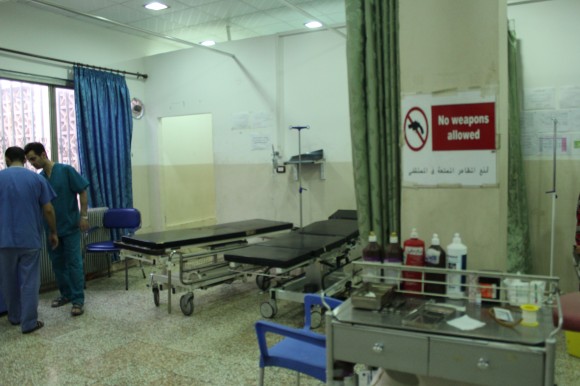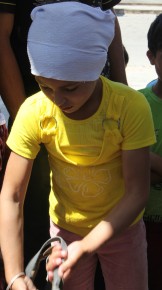
I went to Syria in December 2012, invited by UK based NGO Hand in Hand for Syria. My first view of Atmeh refugee camp, close to the Turkish border, was of a vast sea of muddy white tents. Three days of pouring rain had created a wet landscape of tiny streams running between the tents, while children greeted us shivering.
Since hostilities began in March 2011, 6.5 million people have been internally displaced inside Syria. At the time of my visit, up to 13,000 were in Atmeh fleeing heavy fighting but it was not entirely a safe haven. Just a few days before, a young mother from the camp had suffered severe burns and her 2 children died when her tent caught fire from an oil heater she was using for warmth.
Returning to Syria in August, the camp borders had extended, accommodating 22,000 internally displaced persons (IDPs).The heat was unforgiving with temperatures inside tents above 42 degrees turning them into disease incubators. The medical needs of its vulnerable population are still served by a clinic and pharmacy provided by Syrian NGOs working on the ground, staffed by local healthcare professionals, themselves IDPs.
Taibah is another Northern camp with at least 1000 tents. It’s newer than Atmeh and here we saw no medical facilities at all. A former nurse living in the camp cared for patients as best she could.
She showed us numerous patients laying on tent floors shivering with fevers without medication. Some had confirmed typhoid believed to be from sewage contaminated water supplies.

The UN published a recent report detailing how the regime, and to a lesser extent the opposition, have deliberately targeted healthcare workers. Fundamental laws of war, such as the protection of healthcare workers and casualties in conflict, have been breached. Subsequently a lack of access to deliver aid and provide comprehensive medical support is compounding the plight of civilians caught in the crossfire.
I was based in a Northern Syrian hospital, working alongside Syrian doctors being filmed for a BBC Panorama, Saving Syria’s Children, integrated into an extremely challenging medical environment.
On 26 Aug we had a mass casualty situation when a nearby school was hit by a thermal incendiary device. Thirty students arrived severely burned, 3 killed instantly. A further 8 have died from their injuries. Student Seham Kanbari, 18 was so badly burned her screams seared into my memory, piercing through the chaos.
While recent news reports have focussed on chemical weapons, other lethal weapons used by the regime continue to terrorise the civilian population in the North.
In one Northern village, we visited a children’s hospital. The wider area suffers regular hits from regime aircraft but the village is considered comparatively safe. As we spoke to doctors and mothers of sick children an almighty bang shook the building. A bomb had been dropped nearby. Following a well-practised drill mothers evacuated to the first floor away from windows, carrying their babies with fluids still running through the drips in their arms.
The relentless shelling of neighbouring villages continued throughout the night with the terrifying impact evident on the faces of children I met the next morning at the water well.
This source of water serves a large majority of the villagers and runs precariously close to sewage pipes. Many people become unwell from drinking this. Children with waterborne diseases only have to go as far as the children’s hospital next door.

One girl stood out as she deftly hauled buckets from the 11ft well into which children sometimes fall. Warda, 11, which means flower in Arabic, was tall and slim. Her face looked aged with deep dark circles around her eyes. Speaking beyond her years, she described how her family had fled their home in Damascus because it was too dangerous to stay. She told us she collects water every day for her family now living in the village as she balanced filled buckets onto a wheelbarrow. We asked her what she missed the most: ‘Electricity from a switch and water coming from a tap like home.’
Now back in London, my thoughts often return to my Syrian colleagues and patients. Siham was taken to a specialised burns unit in Turkey, with second and third degree burns covering 70% of her body. Her parents kept a vigil outside her room, sleeping on chairs in the corridor. The institutes headmaster, Mohammed Abu Omar, described Siham as the brightest student at Iqraa, consistently scoring the highest grades as she studied for the baccalaureate. Lying in her intensive care bed, she spoke to the international community through the Panorama film. ‘Please let it be over now, we’ve had all we can take,’ the pain audible in her voice. On Oct 20, nearly 2 months after she was injured, Seham died, despite her own brave battle. Her words must not be in vain.
-----------------------------------------------------------------------------------------
Please note, this is a guest blog. Views expressed here do not necessarily represent the views of DFID or have the support of the British government.
For full details of the UK's humanitarian response to the Syria crisis, please visit: Syria crisis: Latest updates on UK aid.

1 comment
Comment by Second letter of complaint to BBC | Fabrication in BBC Panorama's 'Saving Syria’s Children' posted on
[...] arrived severely burned, 3 killed instantly. A further 8 have died from their injuries.” Saving Syria’s children, 6 November [...]